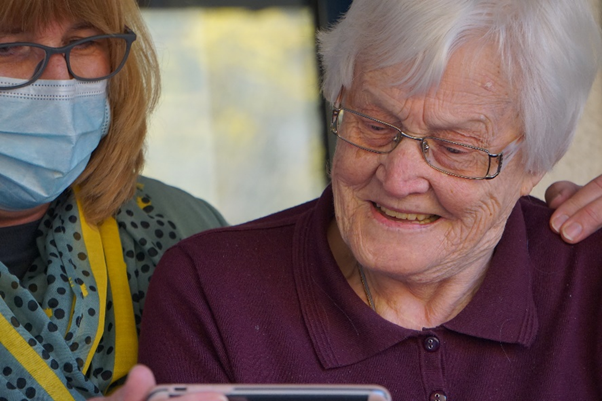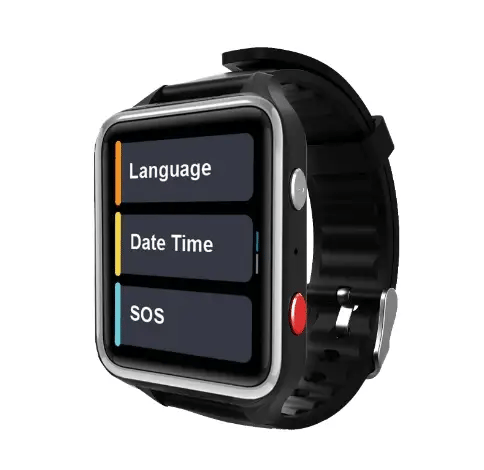In healthcare technology, few innovations hold as much promise and potential for transformative impact as fall detection watches. These devices, designed to alert caregivers and emergency services in the event of a fall, are revolutionising how assisted living facilities and nursing homes care for their residents.
With a focus on enhancing safety, autonomy, and peace of mind, fall detection watches are swiftly becoming essential tools in the care of older people and individuals with dementia.

Understanding the Need
For many individuals living with dementia or advancing age, the risk of falls poses a significant threat to their safety and well-being. According to statistics from Age UK, falls are the leading cause of injury-related deaths among people over the age of 75 in the UK. Moreover, the fear of falling can often lead to decreased mobility and independence, further exacerbating health issues and diminishing overall quality of life.
In assisted living facilities and nursing homes, where residents may require round-the-clock supervision and assistance, fall detection watches offer a proactive solution to this pressing concern. By providing real-time monitoring and immediate alerts in the event of a fall, these devices empower caregivers to respond swiftly and effectively, potentially reducing the severity of injuries and improving resident outcomes.

The Technology Behind Fall Detection Watches
At the heart of fall detection watches lies sophisticated sensor technology capable of detecting sudden changes in motion and orientation indicative of a fall. These sensors are finely tuned to distinguish between normal activities of daily living and potentially hazardous events, such as slips, trips, or falls.
In the event of a fall, the device automatically triggers an alert, notifying designated caregivers or emergency services with the user's precise location and enabling prompt assistance.
One of the most significant benefits of fall-detection watches is their ability to promote independence and autonomy among users. For individuals with dementia or mobility limitations, the reassurance of knowing that help is readily available in the event of a fall can instil confidence and encourage continued engagement in activities of daily living.
This sense of empowerment enhances the user's quality of life and alleviates some of the burden on caregivers, allowing them to focus on providing support rather than constant supervision.
Integration into Assisted Living Facilities and Nursing Homes
The adoption of fall detection watches within assisted living facilities and nursing homes represents a paradigm shift in the delivery of care for older adults and individuals with dementia.
As part of comprehensive care plans, these devices complement existing safety protocols and enhance the overall quality of care. The data collected by fall detection watches can inform preventive strategies and interventions aimed at reducing the incidence of falls and improving resident outcomes over time.
Real-Time Alert System
Fall detection watches provide caregivers with real-time alerts in the event of a fall, enabling prompt response and assistance. This immediate notification mechanism ensures that residents receive timely help, reducing the risk of prolonged immobility or injury.
Individualised Care Planning
By analysing the data collected from fall detection watches, caregivers can gain valuable insights into each resident's mobility patterns and fall risk factors. This information allows for the development of personalised care plans tailored to meet the specific needs of each individual, optimising their safety and well-being.
Continuous Monitoring
Fall detection watches offer round-the-clock monitoring of residents, even during periods when direct supervision may not be feasible. This continuous monitoring capability ensures that residents are safeguarded against falls, providing peace of mind to residents and their families.
Data-Driven Decision Making
The data generated by fall detection watches can be used to identify trends and patterns in fall-related incidents within the facility. By analysing this data, caregivers can make informed decisions regarding preventive measures, facility layout modifications, and staff training initiatives to reduce the overall incidence of falls.
Enhanced Communication and Collaboration
Implementing fall detection watches fosters improved communication and collaboration among caregivers, residents, and their families. By providing transparency regarding resident safety and well-being, these devices facilitate open dialogue and trust, strengthening the sense of community within the facility and promoting a collaborative approach to resident care.

Looking Ahead: The Future of Fall Detection Technology
As technology advances, the potential for innovation in fall detection watches is limitless. From improved sensor accuracy to integration with artificial intelligence and predictive analytics, the future holds exciting possibilities for enhancing the effectiveness and usability of these devices. With an ageing population and growing demand for eldercare services, the need for innovative solutions to address fall-related injuries will only continue to escalate.
Enhanced Safety
Integrating fall detection watches into assisted living facilities and nursing homes significantly enhances the safety of residents, particularly older adults and individuals with dementia who are at higher risk of falls. By promptly alerting caregivers in the event of a fall, these devices facilitate faster response times and reduce the likelihood of serious injuries.
Improved Quality of Care
Fall detection watches complement existing safety protocols within care facilities, contributing to a more comprehensive approach to resident care. Caregivers can leverage the data collected by these devices to gain insights into residents' activity levels, mobility patterns, and fall risk factors, enabling them to tailor care plans and interventions accordingly.
Preventive Strategies
The data gathered from fall detection watches not only aids in responding to emergencies but also informs proactive preventive strategies to reduce falls over time. By analysing trends and patterns in falls-related incidents, caregivers can identify potential hazards within the facility environment and implement targeted interventions to mitigate risks and improve resident safety.
Peace of Mind for Residents and Families
The presence of fall detection watches instils a sense of security and reassurance among residents and their families, knowing that help is readily available in an emergency. This peace of mind fosters a supportive and trusting relationship between residents, caregivers, and family members, enhancing overall satisfaction with the quality of care provided.
Cost-Effective Care Delivery
By reducing the severity and frequency of falls, fall detection watches help mitigate the financial burden associated with fall-related injuries, including medical expenses, rehabilitation costs, and potential legal liabilities. By investing in proactive fall prevention measures, assisted living facilities and nursing homes can save costs while improving resident outcomes and satisfaction.

Conclusion
In conclusion, fall detection watches represent a groundbreaking advancement in assisted living and elderly care. By leveraging cutting-edge technology to mitigate the risks associated with falls, these devices are transforming how we approach safety and well-being for older adults, individuals with dementia, caregivers, and lone workers.
With their potential to enhance independence, support caregivers, and improve outcomes, fall detection watches are not just gadgets but essential tools in promoting a safer and more compassionate environment for vulnerable populations across the UK.
As we embrace the possibilities of this transformative technology, we move one step closer to a future where everyone can age with dignity, security, and peace of mind.
Please contact us if you need assistance. Stay safe, stay protected!


